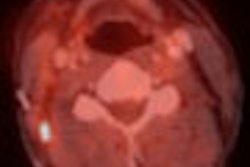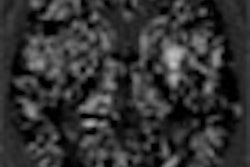VIENNA - CT has shown that it can find nonviable myocardium as well as MRI, but the dose is a whopper. Will it always be thus? A new study from the Netherlands concludes that 40-slice MDCT can detect nonviable myocardial tissue in less than a second -- and less than 1 mSv of radiation.
Dr. Annemarieke Rutten from the University of Utrecht in the Netherlands discussed her group's low-dose nongated protocol on Sunday at the 2005 European Congress of Radiology.
"Imaging of late myocardial enhancement is used to determine the viability of infarcted myocardium," she said. "The contrast agent accumulates in infarcted regions of myocardium that are irreversibly damaged. If you see late enhancement it means there's nonviable tissue. And up to now this has been mainly performed with contrast-enhanced MRI."
The study examined 10 patients (mean age 50) with hypertrophic obstructive cardiomyopathy (HOCM) who had undergone percutaneous transluminal septal myocardial ablation (PTSMA) within two to 21 months.
"(PTSMA) is used as a treatment for left ventricular outflow tract obstructions in hypertropic obstructive cardiomyopathy patients," she said. "HOCM is muscular hypertrophy which leads to left ventricular outflow tract obstruction in some patients. These patients develop symptoms of congestive heart failure and sudden death."
In the study, the patients first underwent retrospectively gated cardiac CT angiography (CTA) following the administration of 100-120 mL of contrast material. Seven minutes later, the patients underwent an additional late-phase scan using the low-dose protocol to determine late myocardial enhancement. The low-dose images were acquired at 32 x 1.25-mm collimation, 1.25 pitch, 80 kVp, and 120 mAs, reconstructed at 3-mm intervals.
Software was used to digitally subtract both sets of images and highlight the areas of large attenuation differences in red. The researchers calculated average CT values in enhanced and nonenhanced portions of the myocardium to assess late enhancement.
According to the results, the average scan time was 0.84 seconds (0.78-0.96), with a mean effective dose of 0.88 mSv (0.79-1.03), Rutten said. All regions of septal ablation showed higher CT attenuation values (average 132 HU, 94-189) than normal myocardium (average 82 HU, 71-107). On the late-phase scan, the region of the PTSMA was about 50 HU higher than the surrounding area on average, Rutten said.
"If you compare the late-phase scan to the CTA, you see that in the region of the septal ablation, you have a difference of around 70 HU, and in the normal myocardium it's only around 9 HU," she said of one patient's image. In two other cases, Rutten stated that they "also saw late enhancement in other regions, which is known to occur in patients with hypertrophic cardiomyopathy."
Evaluation of late enhancement with a 40-slice low-dose MDCT protocol appears feasible, she concluded, with an average radiation dose less than 1 mSv.
An audience member took issue with the comparison of gated CTA to nongated late-phase CT images, which could suffer from bleed-over from the ventricles and skew the results of CT attenuation comparisons, he said.
According to Rutten, the nongated protocol was chosen for the late-phase images in order to minimize the dose. In addition, the researchers mapped both sets of images completely using the same slice thickness, and they appeared to clearly demonstrate the areas of late enhancement. Nevertheless, Rutten said, the group is considering a new study comparing two gated protocols.
By Eric Barnes
AuntMinnie.com staff writer
March 7, 2005
Related Reading
MDCT, maybe equivalent to MRI, tops echo and SPECT for heart function, February 15, 2005
Is MRI the new gold standard for assessing myocardial viability? November 9, 2004
Myocardial ischemia, viability made apparent with MR, February 6, 2004
Oxygen-influenced MRI helps detect viable myocardium, July 2, 2003
MRI better than SPECT for predicting myocardial viability soon after MI, February 19, 2003
Copyright © 2005 AuntMinnie.com




















